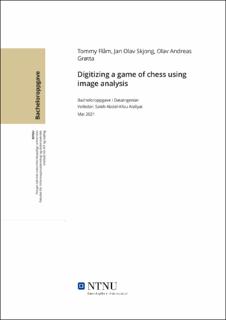| dc.contributor.advisor | Alaliyat, Saleh Abdel-Afou | |
| dc.contributor.author | Flåm, Tommy | |
| dc.contributor.author | Skjong, Jan Olav | |
| dc.contributor.author | Grøtta, Olav Andreas | |
| dc.date.accessioned | 2021-09-24T18:58:07Z | |
| dc.date.available | 2021-09-24T18:58:07Z | |
| dc.date.issued | 2021 | |
| dc.identifier | no.ntnu:inspera:82412805:82415475 | |
| dc.identifier.uri | https://hdl.handle.net/11250/2782122 | |
| dc.description.abstract | Sjakk er et gammelt og tradisjonelt spill som har blitt spilt på samme måte i hundrevis av år, men måten sjakk blir sett på og analysert har blitt forandret fundamentalt de siste årene. Digitalisering av sjakk er i dag veldig viktig for spillere som skal analysere sjakkparti og seere som ser på sjakk. Problemet er at de vanligste metodene i bruk, bruker dyre elektroniske sjakkbrett. Aalesunds Schaklag har problemer med dette, som er grunnen til at vi valgte å hjelpe dem ved bruk av bildeanalyse. Istedenfor å bruke dyre sjakkbrett, trenger denne metoden bare et kamera og en datamaskin til å kjøre et program.
Teori delen av oppgaven gir detaljer om teorien vi originalt hadde planlagt å bruke, men også den teorien vi byttet til å bruke underveis. For å si det så enkelt som mulig, så er all teorien relatert til prosessen med å oppdage et sjakkbrett, oppdage feltene på et brett, oppdage sjakkbrikkene og til slutt spore brikkene gjennom et helt parti. I metode delen av oppgaven beskriver vi organisasjonen av prosjektet og de forskjellige verktøyene som ble brukt underveis.
Prosjektet har resultert i et program som kan oppdage et sjakkbrett, feltene på sjakkbrettet og brikkene på feltene. Prosjektet har rom for forbedring når det kommer til sporingen av brikkene, siden vi ikke fikk dette til å virke med den nøyaktigheten vi ønsket. I tillegg fikk vi ikke, for forskjellige grunner, testet programmet på sjakklubben, men vi vil sende instruksjoner om hvordan de kan bruke det. | |
| dc.description.abstract | Chess is an old and traditional game which has been played the same way for centuries, but the way the game is viewed and analyzed has been fundamentally changed the last few years. Digitizing games of chess today is important for players analyzing games, and for providing the best experience for viewers watching games. However, the methods currently in use utilize expensive electronic chessboards. Aalesunds Schaklag has experienced this exact issue, which is why we decided to help them. The way we did this was by using image analysis to digitize games. Instead of using expensive chessboards, this method only requires a camera and a computer to run a program.
The theory part of the thesis details the theory we initially were planning on using, and also the theory which we switched to using during the project phase. To put it simply, all of the theory is related to the four steps of detecting a chessboard, detecting the squares, detecting the chess pieces and finally tracking the pieces over the course of a game of chess. In the method part of the thesis, the organization of the project is discussed as well as all of the different tools used over the course of the project.
The project has resulted in a program which can detect a chessboard, the chessboard squares and the pieces on them. The project has room for improvement when it comes to the tracking of the game, since we did not get this to work with the desired accuracy before the deadline of the project. Additionally, for different reasons we were not able to test the product at the chess club, however we will provide a guide on how to use it, for the client. | |
| dc.language | eng | |
| dc.publisher | NTNU | |
| dc.title | Digitizing a game of chess using image analysis | |
| dc.type | Bachelor thesis | |
